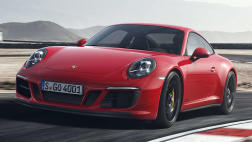The Hyundai Excel was a huge seller in Australia in the mid-to-late 1990s. These days it’s common to see small cars at the head of the sales race but that was a rare occurrence back then. Yet the Excel was frequently in the top three in the overall sales race, hitting the first position on one big occasion. Obviously there is now a huge number on the used-car scene.
A combination of a spacious interior, good looks and reasonable performance certainly helped push the Excel to the top, but to be honest its low price was the main reason for the sales success. A low price that was further enhanced by Hyundai's famous “driveaway no more to pay” system. Nowadays ‘driveaway’ is very much part of the automotive vocabulary but it was a revelation in the late 1990s and Hyundai led the way.
Early Hyundais were on the rough and ready side, but build quality improved substantially over the years the Excel was on the Australian market. The later Excels have body fit and paint finish that's almost to Japanese standards. However, interior fit and finish can be on the rough side at times so have a close look at the cabin of the car you’re considering.
The automatic is a relatively expensive option and reduces the engine's performance
Hyundai Excel is offered in three-door and five-door hatch bodies as well as a four-door sedan. The three-door hatches were the price leaders so are far and away the most common. These are fairly sparse in their standard gear, but many will have air conditioning as it was frequently included in special deals.
Check the car to see if it meets your standards as far as upholstery and seat comfort are concerned. Excels were never particularly good in this respect even when new and later model competitors, including Hyundai's own Accent, provide more refinement and comfort.
Excel is simple to drive and park when power steering is fitted but can be hard to operate in tight parking situations if it’s not. Check it for yourself if you are not sure by driving at very slow speeds while moving the steering wheel all the way from one lock to another.
Handling is good, with a more sprightly feel than is normal in similar Japanese cars. A good set of tyres can further improve the Excel and is worth considering if you class yourself as a driving enthusiast.
Talking about enthusiasts, beware of the Excel that has been fitted with an outrageous body kit, huge exhaust tailpipe, extrovert instruments and other over-the-top embellishments.
The automatic is a relatively expensive option and reduces the engine's performance
Engine capacity in the Excel is 1.5 litres. It used a single overhead camshaft allied to fuel injection until January 1998 when a twin-cam unit of the same size was installed. The latter is naturally livelier, but there's nothing wrong with the older single-cam engine.
Five-speed manual and four-speed automatic transmission are offered in all models being looked at in this feature. The five-speed can be a bit sloppy in its action, which takes the edge off an otherwise pleasant car.
The automatic is a relatively expensive option and reduces the engine’s performance, as well as increasing petrol usage, so is probably best left to those who do a lot of suburban driving.
The Excel model range begins with the price leading Excel Sprint, then goes up through GX and LX to the topline Excel GLX. The Sprint is fairly basic to keep its price down so the rest of the range appears relatively expensive in comparison.
Spare parts are generally reasonably priced and there are plenty of Hyundai dealers in Australia. As the car is ageing some dealers may be running out of spare parts but there are plenty of aftermarket recyclers (aka wreckers) with good stocks of bits. It may be worth enquiring about spares in your local region before becoming too involved with the purchase decision.
While the Accent hasn't enjoyed the runaway success of its predecessor it is better built and more refined
Most good amateur mechanics can do their own repairs, but don't tackle safety items unless you know what you are doing. As always, it’s smart to have a workshop manual on hand before pulling the car apart.
Insurance costs are normally low, though they can be expensive in relation to the price of the car if you are a young driver getting into your first car and haven't had time to build up a no-claims history.
Shop around before becoming seriously involved in the car, and make sure you understand what you are getting in the way of coverage.
Excel was replaced by the Hyundai Accent in June 2000. While the Accent hasn’t enjoyed the runaway success of its predecessor it is better built and more refined, so is well worth considering if you can raise the extra money.
WHAT TO LOOK FOR
These cars are getting on in years so don’t expect perfection, on the other hand expensive repairs can ruin your bank balance so make sure to get a quote for all problems.
Make a thorough inspection for crash repairs. Check for paint that doesn’t match, paint overspray, ripples in the body panels and for roughly-repaired out-of-sight areas. Rust proofing appears good and the only cars we have seen with problems are those that haven't been properly repaired after a crash.
Check the conditions of the seats, trim, plastic parts and the operation of all the controls. During your test drive listen for squeaks or rattles from around the car.
We have heard of problems with high oil consumption, possibly due to poor maintenance. Listen for noises from the top end of the motor at idle and under hard acceleration.
Be wary of an engine which hesitates at any time, especially when accelerating anything more than moderately. Watch for smoke from the exhaust when the engine is worked hard.
Gearchanges tend to be on the sloppy side at times, but if you get one which seems too bad, and/or is reluctant to go into gear have an expert look it over. Listen and feel for a vibration from the power-steering pump.
CAR BUYING TIP
The more popular the car the more there are on the used scene. Use this to your advantage by shopping around for the best of them.
Hyundai Excel 1994:
| Safety Rating |
|
|---|---|
| Engine Type | Inline 4, 1.5L |
| Fuel Type | Unleaded Petrol |
| Fuel Efficiency | 8.0L/100km (combined) |
| Seating | 2 |
| Price From | $2,640 - $4,070 |






.jpg)




.jpg)

_0_0.jpg)

.jpg)

.jpg)
Comments